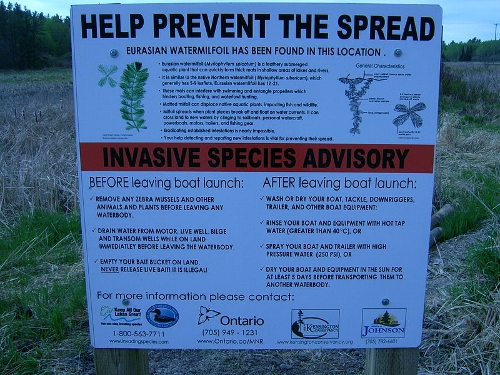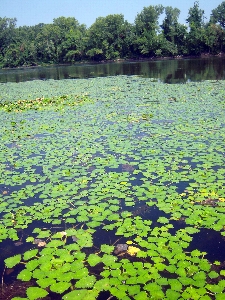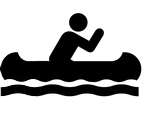The Adirondacks are widely considered one of the most beautiful and unique landscapes on Earth, and thus, attracts tourists who want to experience wilderness to separate themselves from everyday life. As beautiful as paddling from one lake to the next is, the popularity of the Adirondack lakes is causing serious environmental problems. Many invasive species not native to upstate New York, or even the North American continent, are growing uncontrollably in the park’s streams and lakes. According to the New York State Department of Environmental Conservation (DEC), “invasive species threaten nearly every aspect of our world and are one of the greatest threats to New York’s biodiversity”. Not only do invasive species threaten biodiversity, but they also contribute to wildlife habitat destruction, agricultural damage, and economic loss (NYS DEC).
These environmental problems are all exacerbated by flat-water paddling and boating traffic, which provide easy transportation for invasive species from one river system to the next. Many backcountry paddlers carry their boats over land between lakes and river systems. However, they do not often pay attention to the plants or animals attached to their boats. Once these contaminated boats are placed in the new body of water, the invasive species falls off. This starts a dangerous cycle of uncontrolled growth and reproduction in a new habitat that is void of natural predators. The aquatic plant species that threaten the park’s water systems are the Eurasian watermilfoil, curly-leaf pondweed, European frogbit, brittle naiad, fanwort, variable leaf milfoil, and the water chestnut. The Asian clam, quagga mussel, spiny waterflea, round goby, and white perch are all aquatic animals that have contaminated some of the park’s lakes (NYS DEC, Invasive Species).

Signs describe how to properly handle and dispose of watermilfoil. (Fungus Guy/Wikimedia)
The state is attempting to completely stop the spread of invasive species in the Adirondacks. Park volunteers monitor population levels of invasive species in many bodies of water and inspect boats along carry trails and at boat launches in order to stop species from hitchhiking. Since flat-water paddling and recreation has a huge impact on the spread of invasive plants and animals, the state of New York is going to great lengths to educate boaters on prevention methods. Besides the many volunteers teaching tourists and residents on how to properly clean boats and equipment, disposal stations are located at many boat launches. These provide a safe and convenient place to dispose of the invasive species so they no longer harm the local ecology (NYS DEC, Disposal Stations).
The issue of invasive species in Adirondack State Park has become so catastrophic that the state legislature and governor are making strides to intervene by implementing new environmental regulations. In March of 2015, Governor Andrew Cuomo, along with 53 governmental and non-governmental organizations, committed to stop the spread of aquatic invasive species in the park (NYS Cuomo). The government allocated $1 million towards this effort for the year of 2015 in order to prevent much greater losses in the future. It is estimated that invasive species would cost the New York State government $900 million, due to a combination of removal fees, decrease in economic revenue from decreased tourism, and the loss of taxes from park residents (NYS Cuomo).

Water chesnut, an invasive species, taking over a lake in Massachusetts. (Maddie List/USFWS/flickr)
Invasive aquatic species greatly impact the waterways they inhabit. They outcompete native species and disrupt the entire waterway ecosystem. If the invasive species are left unchecked to grow rampant underwater, native species that once flourished in the pristine Adirondack waters could become extinct. With government regulations, the efforts of local residents, and the diligence of tourists, the battle for biodiversity will hopefully stabilize in the near future.
_______________________________________________________________________________________________________
Works Cited:
1. "Aquatic Invasive Species in New York State." Nuisance & Invasive Species. N.p., 2015. Web. 06 Apr. 2015.
2. "Common Aquatic Invasive Species of NY." Common Aquatic Invasive Species of NY. New York State Department of Conservation, 2015. Web. 06 April 2015.
3. "Invasive Species Disposal Stations." New York State Department of Environmental Conservation, 2015. Web. 27 Apr. 2015.
4. "Governor Cuomo Announces Agreement to Prevent Spread of Aquatic Invasive Species in the Adirondacks." Governor Andrew M. Cuomo. New York State, 10 Mar. 2015. Web. 27 Apr. 2015.
Photos Cited:
- Signs describe how to properly handle and dispose of watermilfoil. (Fungus Guy/Wikimedia) (http://commons.wikimedia.org/wiki/File:Eurasian_watermilfoil_warning_sign,_Desbarats.JPG)
- Water chesnut, an invasive species, taking over a lake in Massachusetts. (Maddie List/USFWS/flickr) (https://www.flickr.com/photos/usfwsnortheast/4791162788/)

